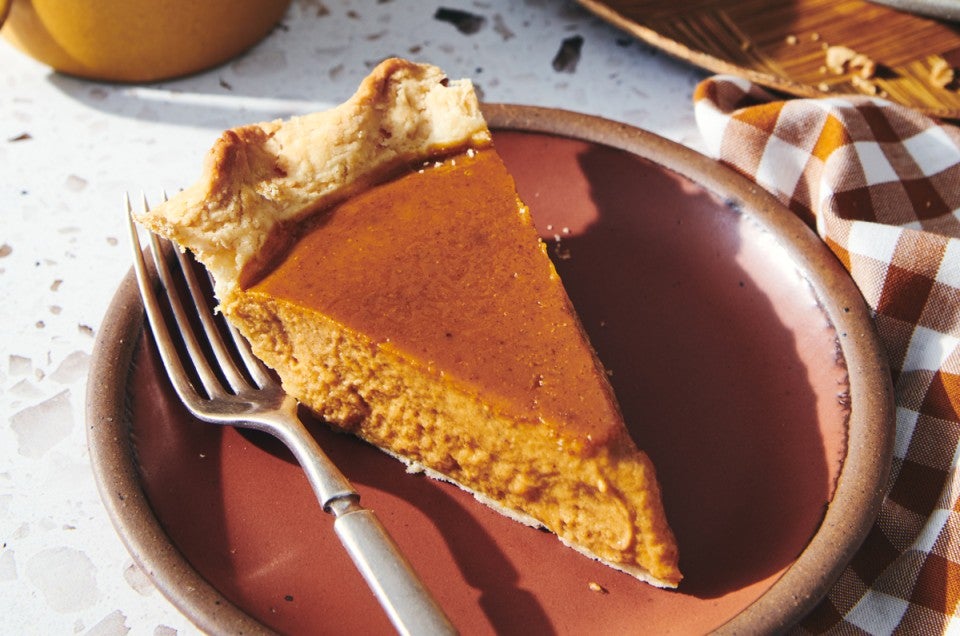How to tell when pumpkin pie is done
It can be trickier than you think — here’s what to look for.


 The bakers of King Arthur are here to solve the kitchen conundrums you share with us, whether on the phone, computer, or by the good old postal service. In Ask the Baker’s Hotline, Annabelle picks the brains of the talented King Arthur Baker’s Hotline to tackle your most-asked questions. Today’s query: When is pumpkin pie done?
The bakers of King Arthur are here to solve the kitchen conundrums you share with us, whether on the phone, computer, or by the good old postal service. In Ask the Baker’s Hotline, Annabelle picks the brains of the talented King Arthur Baker’s Hotline to tackle your most-asked questions. Today’s query: When is pumpkin pie done?
* * *
Pumpkin pie is a staple at many holiday meals, but baking one can sometimes be a stressful undertaking. With its already-brown custard filling, it can be tricky to nail exactly when it’s done. Pull your pie out of the oven too soon and the eggs won’t have had enough time to set, leading to a runny filling when you slice it. Bake it for too long, and the eggs will over-coagulate (tighten), cracking the surface and creating a curdled mouthfeel. But that’s why we’re here to help! With a few key cues, you’ll have the confidence to know when your pie is not only done, but perfectly done.
Ryan from the Baker’s Hotline is here to let you know what to look for each step of the way. Never fear a runny, cracked, or curdled pumpkin pie again!
See how the whole surface of this pie is still quite liquid? It's too soon to pull it from the oven; if you do, your filling will be runny and your slices will collapse.
Here, you can see that the full surface of the pie is matte and mostly set, with little jiggling in the center. It's overbaked, and risks cracking and a grainy mouthfeel.
“There are four key cues that can be used to determine when a pumpkin pie is ready to come out of the oven,” says Ryan.
“The center is going to look wobbly. That’s OK!” Ryan assures us that you want to remove the pie from the oven while the center still looks underdone for one very important reason: carry-over cooking. This is when the pie continues to cook from residual heat after you’ve taken it out of the oven. “Take it out when there’s an approximately 4" circle of jiggly (think Jell-O) filling in the center of a standard 9" pie,” he says.
You don’t want to whole pie to be wobbly, though. “The edges should look set about 2" from the edge of the pie,” Ryan says. This means they’ll be matte rather than shiny, they should stay put when the pan is jiggled, and they may have a slight domed appearance.
“If you have a digital thermometer, you can use temperature as your gauge, but it’s not our first recommendation,” Ryan says. “You want the center to read 160°F to 170°F, the range where eggs coagulate.” Above 175°F, you risk dry, overbaked edges and a cracked center as the pie cools. “The downside to using a thermometer,” Ryan explains, “is that it leaves a hole in your pie, which can encourage additional cracking … but that’s what whipped cream is for, right?”
Recipe bake times are great guidelines, but every oven bakes differently. “Start checking for proper doneness about 10 minutes before the recipe states,” Ryan recommends. “It’s always easier to add additional time, but once you go too long, there’s no turning back.” We suggest always using an oven thermometer to make sure you’re baking at the correct temperature.
With these visual cues and tips, we hope you’ll have the prettiest pumpkin pies this season.
Cover photo and food styling by Liz Neily.


